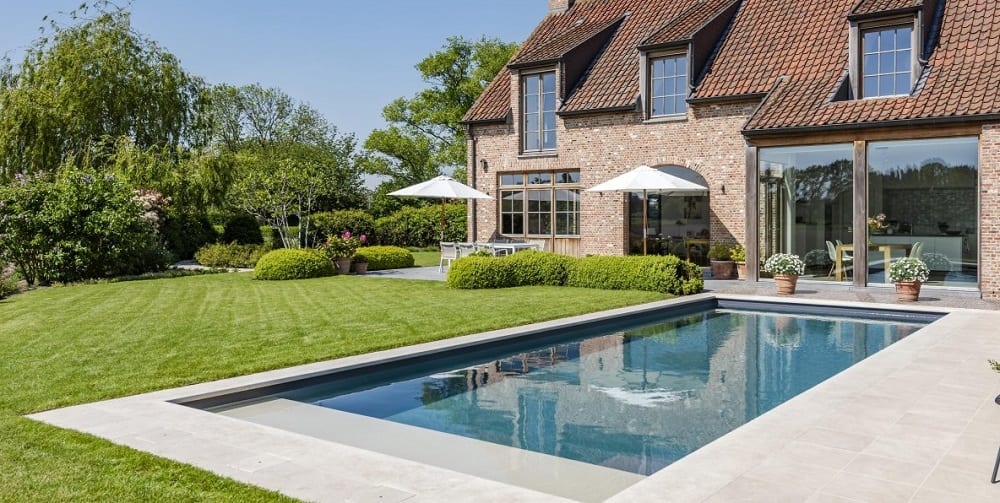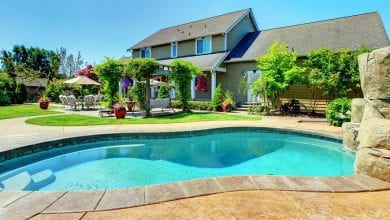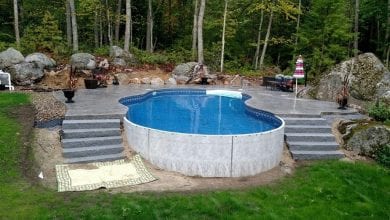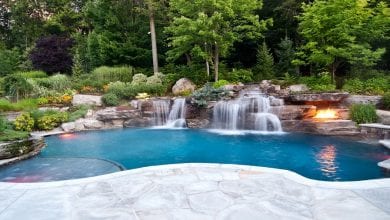
How To Clear Cloudy Pool Water Fast
It doesn’t matter how clean you think your pool is, if it’s cloudy, then no one is going to want to swim in it. Of all of the conditions that can affect a pool, cloudy water is right up there with algae overgrowths. In other words, it’s ugly and no one wants a cloudy pool. Unfortunately, making the water in a pool crystal clear isn’t always as easy as it should be and that’s why we’ve decided to write a guide on the subject to clear up any misconceptions about it.
Although we know that cloudy pools tend to frustrate many people, fixing the problem isn’t as difficult as most people think it is to solve. All it requires is the pool owner to know the basics over why their pool’s water might be clouding up and then they can quickly correct. Follow along with us as we go through some of the causes of cloudy water and then offer up some solutions to solve these problems.
The Causes Of Cloudy Water
As we feel any expert would say, you can’t clear up a problem without first knowing what it is that causes said problem. That’s why we wanted to go over some of the more common causes of swimming pool cloudiness. Let’s look at some of these causes, so we can get a clearer view of pool cloudiness—if you’ll excuse the pun.
Free Chlorine Levels
One of the main causes of cloudy water is a pool environment with too little free chlorine. Low free chlorine will not only create cloudy water, however. It will also create a harmful pool environment by not properly killing the germs and bacteria to grow. This can cause higher levels of ammonia, and algae bloom. Surprisingly, low free chlorine levels tend to smell more chlorine because the chloramines are at too high of a level and there isn’t enough free chlorine available for disinfection of the pool’s water.
Too Much Ammonia
Another cause of cloudy water is too much ammonia in the water. This is somewhat of a rare event, but can sometimes happen when pools are first opened up for the season. After sitting over the winter, the pool owner might find that it’s hard for them to clear their pool’s water. That their normal application of chlorine just isn’t raising free chlorine levels or cyanuric acid levels.
Too Many Algae
This problem can also happen after the pool sits for a long period of time. When algae first start, it looks quite a lot like cloudy water caused by other problems, so it’s important to determine if what you’re actually dealing with is too many algae or water cloudiness caused by low chlorine levels.
To determine whether algae is the cause of water cloudiness, you can perform an Overnight Chlorine Loss Test or an OCLT. This test is performed by adding chlorine to the pool in the evening and then testing it in the morning. If the levels of free chlorine fall by more than 1 part-per-million (ppm), then the test is positive and you have algae that are beginning to grow. This problem requires quick work to solve the problem as algae can quickly cause free chlorine to continue to dive as it advances.
An Out-Of-Whack Chemical Balance
Another thing that can cause pool cloudiness is an imbalance in chemicals. Maybe it’s too much or too little chlorine, maybe is calcium hardness, and maybe it’s imperfect cyanuric acid levels. It might even be pH levels or alkalinity levels that have missed their target. That’s why it’s important to own and use a pool testing kit to make sure the chemical profile of the pool is balanced. We’ll discuss more of that later, however.
A Filter That Isn’t Working Properly
A faulty filtration system is another thing that can cause cloudy water. Why isn’t the pool filtering effectively? Well, it can be due to several different things. It can be because the filter is clogged or the filter cartridges have worn out. It could also because the scale is built on the filter, or maybe that the pump itself is starting to wear out and isn’t doing its job anymore.
A Buildup Of “Junk”
The last thing that can cause water to become cloudy is a buildup of what we would like to call “junk.” That’s really the only way to describe it as the junk might vary from pool to pool. What we consider junk particles includes insects, bird poop, minerals, pollen, dust, dirt, and a wide range of other things. The best way to avoid these particles from clouding your pool is by maintaining a weekly cleaning schedule.
Clearing Up Cloudy Pool Water…Fast!
Okay, now that we’ve gone through some of the things that cause pool water cloudiness, it’s now time to talk about what we can do to clear up cloudy water. Even though we understand that cloudy water can seem like an insurmountable problem at first, it really can be quickly remedied if you have the proper tools and know what needs to be done. We can help by showing you the steps to a clearer pool.
Step One: Gather Together The Tools You May Need
The first thing that you will want to do is to get together some of the tools that you’ll need for this project. And we say for this stage you should be well prepared for whatever happens to be the problem with your pool. That means to have some basic equipment and chemicals on hand—even if you may not need or use them at this moment. Some of the things that you’ll need includes:
- Pool Brush
- Pool Net
- Test Strips Or Test Kit
- Calcium Hypochlorite Shock
- Water Clarifier
- Non-Chlorine Shock
- Chlorine
Step Two: Test The Water
The next thing that you’re going to want to do is to test the water to see if the cloudy condition is related to unbalanced water chemistry or if it is related to one of the other conditions we’ve mentioned. Some of the problems that the test might turn up include a difference between Total Available Chlorine and Free Available Chlorine, or No or Low Chlorine Levels. Let’s look at each of these conditions separately to see if either one of these problems is the culprit for your cloudy water.
TAC Versus FAC Levels
If your pool testing kit is showing a difference between Total Available Chlorine (TAC) or Free Available Chlorine (FAC), then you’re going to have to use a non-chlorine shock on the pool. There are a lot of different shock products on the market, so you should find the one that meets your pool type the best. Just be sure to follow the directions on the package to the letter when you’re using it to remove pool cloudiness.
No Or Low Chlorine Levels
If your pool test kit shows that your chlorine levels or either low or nonexistent, then you’re going to have to use a calcium hypochlorite shock. As is the case with the use of any pool chemical, it’s important to thoroughly read and understand the directions, and follow them to the letter.
Check Overall Pool Chemistry
While you’re looking “under the hood” by checking the pool’s chemical composition, it’s a good idea to make sure the rest of the pool is balanced. If the Total Dissolved Solids (TDS) is high or there’s High Calcium Hardness, then the pool can be cloudy. The same thing goes for pH levels and Total Alkalinity levels. Therefore, it’s always a good idea to make sure that the pool’s chemistry is properly balanced.
Step Three: Check The Pool’s Circulation
If your test of the water has shown that it’s perfectly balanced, or if your water chemistry corrections didn’t make a difference, then you might have another problem altogether with your pool. And the one problem it might be is that the filtration system might not be doing its job.
The problem could be a clogged filter, mineral buildup, or even a pump that isn’t holding up its end of the bargain anymore. If you do find out that it’s a mechanical failure instead of a chemical imbalance, then be sure to correct it as soon as possible.
Step Four: Maybe It Just Needs Clarifier
If you’ve examined the chemistry of the pool as well as its mechanical parts, and it still is cloudy, then you might just need to use a clarifier in the pool. A clarifier binds together small particles so they can be removed by the pool’s filtration system. Start by using a net on the top of the pool and then adding some pool clarifier into the pool’s water according to the product’s instructions. Once that’s done, run the pump at high speed continuously until the water begins to become clear again.
Some Additional Pool Clarifying Tips
Scrub It A Little Bit
While you’re adjusting chemical levels, making sure pool pH levels are proper, and using clarifyer, you might as well go ahead and do a little bit of cleaning. You might as well skim the water, and break out the pool brush and give the floor and walls a little bit of a scrub. That way the pool not only looks clean but is actually clean.
Empty All Of The Baskets
Another thing that you can do to keep the pool looking clean is by emptying the skimmer basket and the hair & lint pot. The skimmer basket is installed right on the side of the pool and its primary purpose is to skim the pool’s surface before debris builds up to such a large level that it sinks to the bottom of the pool. The more effective the skimmer is, the better it can skim these particles off of the water’s surface. And it can only do this job if the skimmer is clean of all debris. If it’s not, then it won’t do its job as well as it could.
The skimmer basket isn’t the only debris collection device that your pool has. There is also something called the hair and lint pot and that’s found in the pool’s pump. This pot is designed to catch any of the debris that the skimmer might have been unable to collect. Even though this part of the pump only needs to be cleaned out every couple of weeks or so, if it’s full, then it will impede the performance of the pump and that could lead to more pool cloudiness.
Keep The Water Level Up
Another thing that can lead to pool water cloudiness is an improper water level. If the water level is too high or too low, it’s not only near impossible for the skimmers to do their job, but it also makes it difficult to maintain proper chemical levels. And that’s not even mentioning the fact that if the water is too low, it can cause the pump to dry up and eventually burn up, or if the water is too high, then the skimmer won’t do its job and remove debris from the pool.







